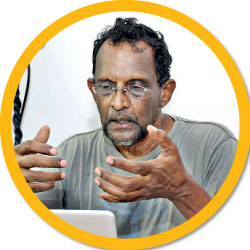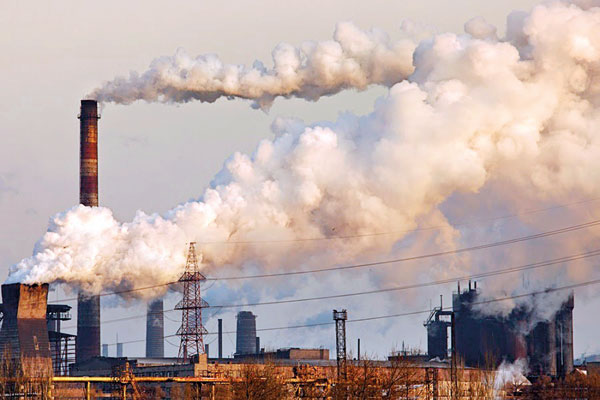|
Sri Lanka will be faced with severe environmental degradation and health issues in future
– Systems Ecologist Dr. Ranil Senanayake
 Speaking to the , Chairman of the Conservationist Group, Rainforest Rescue International and Systems Ecologist Dr. Ranil Senanayake warned that the construction of the Sampur coal power plant would not only cause environmental concerns, but also would be a root cause leading to the destruction of the country’s cultural heritage, including the sacred Bo Tree. Stating that Sri Lanka has sufficient electricity generated under the present scenario, he raised the question as to why CEB is determined to have another coal power plant in Sri Lanka. Speaking to the , Chairman of the Conservationist Group, Rainforest Rescue International and Systems Ecologist Dr. Ranil Senanayake warned that the construction of the Sampur coal power plant would not only cause environmental concerns, but also would be a root cause leading to the destruction of the country’s cultural heritage, including the sacred Bo Tree. Stating that Sri Lanka has sufficient electricity generated under the present scenario, he raised the question as to why CEB is determined to have another coal power plant in Sri Lanka.
“When the coal burns out, it will release 10, 000 tons of Sulphur Dioxide, 10, 200 tons of Nitrogen Oxide, 3.7 million tons of Carbon Dioxide, over 500 tons of SO2 (small particulate matter which sticks in your lungs) and 420 tons of Hydro Carbon. In addition, it would put out 225 pounds of arsenic, 114 pounds of lead and four pounds of cadmium per annum. - Dr. Ranil Senanayake
“The CEB cost out the price of electricity generated only from coal but they suggest that the Government of Sri Lanka or the public must bear the cost of the transmission lines, infrastructure, pollution and any other damage that will have to be incurred in the process of constructing the coal power plant. This is a cheat and we must immediately start looking as to why we need this coal power plant in the first place. In today’s world, the alternative energy producing scenarios are huge in potential for us” Dr. Senanayake said.
Quoting President Sirisena at COP 21 in Paris, he said that Sri Lanka’s vision was to move towards a fossil free path for development. However, Dr. Senanayake said that the scenario created by the CEB was contrary to this. “According to the projections made by the CEB, we can become all sustainable in energy production in another twenty years’ time and Sri Lanka will have the potential to export its electricity to India. This is the danger we face where India will bring all its pollution to Sri Lanka since they can buy cheap electricity. We will be loaded with pollution and severe environmental damage. First we must question the CEB on the need for a coal power plant and on their growth projections on this regard. Their growth projections are not correct and questionable” he said.
“A coal fire power plant on a grid of 500 MW burns roughly about one million to one and a half million tons of coal. It uses about 2.2 billion gallons of water and 146 tons of limestone. This Limestone is used to capture the flue gases. The new coal fire plant is not going to use even this technique. What they are going to use instead is sea water. Can you imagine what the repercussions of this initiative could be in future? Coral bleaching is about to happen due to the warming of the oceanic temperature. If we put hot water into the Trincomalee Bay unchecked, it will destroy all the corals.
When the coal burns out, it will release 10, 000 tons of Sulphur Dioxide, 10, 200 tons of Nitrogen Oxide, 3.7 million tons of Carbon Dioxide, over 500 tons of SO2 (small particulate matter which sticks in your lungs) and 420 tons of Hydro Carbon. In addition, it would put out 225 pounds of arsenic, 114 pound of lead, four pounds of cadmium per annum. During the North East monsoon, the heavy metals, cadmium, lead, arsenic and hydro carbons will be blown over the NCP and the poor farmers suffering from the kidney diseases will have another whole range of diseases on their head. Their immune system is already weak and this will bring doom to the entire population in the NCP.
During the entire period of the North East Monsoon, wet air comes across. When sulphur dioxide and oxides of nitrogen interact with wet air, nitric acid and sulphuric acid is formed. This is common all over the world. In fact, the Black Forest in Germany died as a result of acid rain. The Sampur coal power plant or any other power plant in that area is definitely going to create acid rain. Acid rain that comes with the North East monsoon will travel across Polonnaruwa, Anuradhapura, Sigiriya and Dambulla where the entirety of the Sinhala culture resides. Everything from Gal Viharaya to the Aukana Buddha will dissolve as it has happened all over the world with acid rain coordinating. The acid rains will also destroy the Sacred Bo Tree.
Do we, as Sri Lankans, want this sin on our heads? For 2,500 years we have been maintaining the sacred Bo Tree. We cannot let anyone destroy such precious gifts that we should leave behind for our future generation. I am horrified that the Central Environmental Authority who is supposed to be our environmental watchdogs has not commented on this matter. While the average Sri Lankan understands this, it is a pity that respective authorities have turned a blind eye on this situation” Dr. Senanayake added.
During the 1960’s, Sri Lanka was a true paradise and as a diver back then, Dr. Senanayake has witnessed a rich bio diversity of marine life unequivocal to any part in the world. According to him, Trincomalee Bay contains an enriched marine biodiversity which should be conserved at all cost. It consists of an extremely deep canyon where it is located; a place which brings deep sea organisms almost to the shore. It is known as one of the safest places for tourists to explore the depths of the sea bed unharmed and unafraid.
“Since the Mahaweli cuts the trench which has the ability to have cold water at the bottom and warm water at the top, we have a per unit area of bio diversity in Trincomalee unlike in any other place in the world. The bay consists of a deep water bio diversity which extends right up to the shallow water bio diversity. If we allow these people to dump their garbage there and take the cold water from the bay and pump it back as hot water, this will destroy the marine eco system. Another aspect of the marine environment in Trincomalee is the abundance of marine mammals in this region. When the force of the water from Mahaweli River flows down the sea, an up-welling of the cold water is created naturally. It should be understood that when there is a cold water up-welling, nutrients in the water are brought up forming planktonic blooms. Planktonic blooms attract whales in concentrated amounts as can be witnessed in Trincomalee. In case coal ships navigate through this area, ship strikes would be inevitable.
Beyond the whales, all those bays could be coral gardens. With climate change coming up now coral bleaching events are going to be more and more common in future. We need to find a sheltered and shaded base if possible so that the corals will have a safe area as refuge where they can be conserved. Trincomalee is the ideal and perfect place for such an endeavour. However if the water is acidified as the coal power plant would do in near future, it wouldn’t help in protecting the corals. Moreover, a coal power plant that is going to release clouds of smoke into the air will not be the conductive approach towards tourism in Trincomalee. Just for the greed of coal, we cannot let the CEB or the politicians who coax the Indians into this project, go ahead with the Sampur coal power plant project. We, as Sri Lankans should object to this since it is our culture, our history and our nation that are going to be destroyed” Dr. Senanayake added.
|

 The imminent threats to the environment of the proposed 500 MW coal-fired thermal power plant to be established in Sampur are grave in concern and are not reversible if commenced. Amidst the vehement opposition by environmentalists and concerned area residents of Sampur, the green light has already been given by the Central Environment Authority (CEA) and other respective bodies to kick start the coal power project in Trincomalee.
The imminent threats to the environment of the proposed 500 MW coal-fired thermal power plant to be established in Sampur are grave in concern and are not reversible if commenced. Amidst the vehement opposition by environmentalists and concerned area residents of Sampur, the green light has already been given by the Central Environment Authority (CEA) and other respective bodies to kick start the coal power project in Trincomalee.